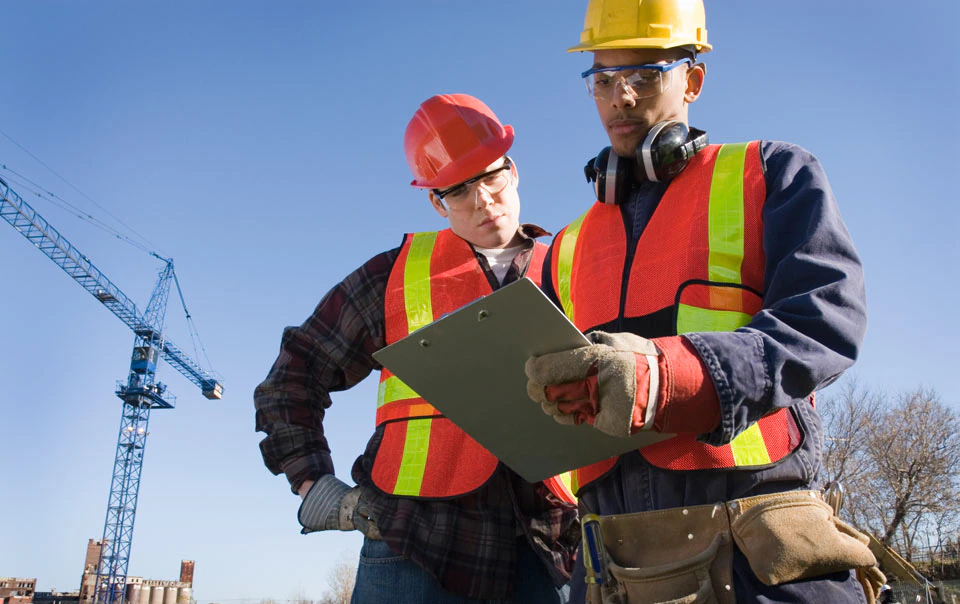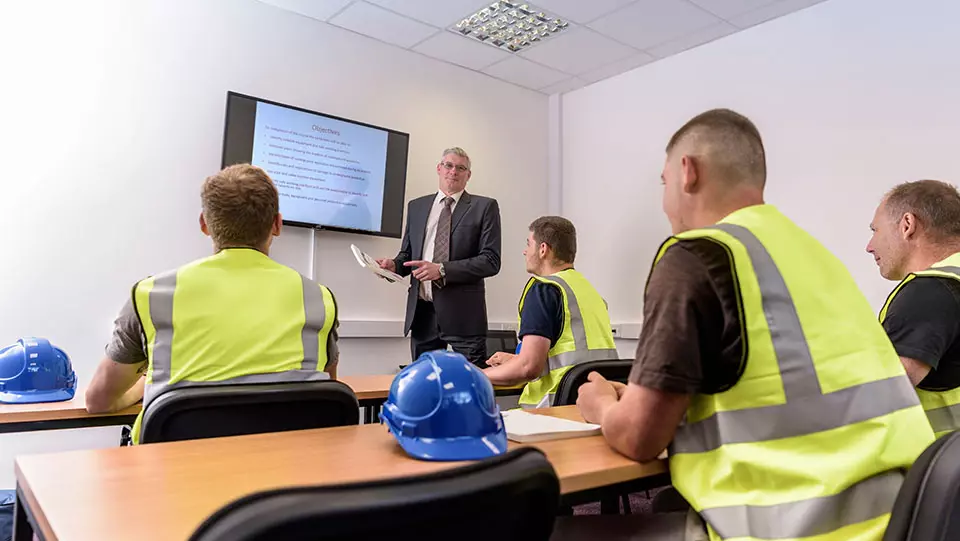What Are Roles and Responsibilities During Crane Operations?

(MUSIC)
(DESCRIPTION)
Travelers logo
TEXT: Crane Safety: Roles and Responsibilities
(DESCRIPTION)
A white silhouette of a crane stands against a red building site. The crane swings a large crate over the site, then drops it off its hook in an uncontrolled fashion. It crashes to the ground.
TEXT: Most Critical, Most Expensive, Potentially Dangerous
(SPEECH)
It's impossible to overestimate the impact a crane accident can have on your construction business. Not surprisingly, cranes are one of the most critical, expensive, and potentially dangerous pieces of equipment on a jobsite,
(DESCRIPTION)
A white smoke emerges in the foreground
TEXT: Serious Injuries, Property Damage, Schedule Delays, Budget Issues
(SPEECH)
bringing significant risk to people, property, and your bottom line.
(DESCRIPTION)
Silhouettes of workers wearing hard hats stand in a line.
TEXT: Well Trained, Qualified
(SPEECH)
The first step to minimizing the potential for crane accidents is making sure all the members of your team are well trained and qualified to perform their job safely.
(DESCRIPTION)
Nine red boxes appear on screen. Four silhouettes of workers appear.
TEXT: FOUR KEY ROLES
(SPEECH)
Let's briefly walk through four key roles involved in crane operations and a small sample of their responsibilities. And we'll let you know where to get additional insights so you can lift and load with what you've learned here.
(DESCRIPTION)
Zoom in to one of the boxes to see a silhouette of the crane owner.
TEXT: CRANE OWNER
(SPEECH)
The crane owner is responsible for providing a crane that meets the needs for the job as specified by the crane user.
(DESCRIPTION)
Split screen with the crane owner
TEXT: Maintenance, Repair, Transport, Assembly, Disassembly, Inspection
(DESCRIPTION)
A crane and three checkboxes appear. Each checkbox is marked with a black check.
(SPEECH)
They're also responsible for designating qualified personnel for maintenance, repair, transport, assembly, disassembly, and inspection of the crane or cranes.
(DESCRIPTION)
Transition to a silhouette of the crane user.
TEXT: CRANE USER
(SPEECH)
The crane user is responsible for ensuring crane operations
(DESCRIPTION)
Split screen with the crane user
TEXT: Manufacturer's Requirements, Safety Regulations
(SPEECH)
comply with the manufacturer's requirements and the applicable safety regulations. In addition, they must make sure that the crane is in proper operating condition and that inspections are up to date.
(DESCRIPTION)
Transition to a silhouette of the site supervisor, split screen
TEXT: SITE SUPERVISOR
(SPEECH)
The site supervisor must make sure that the crane area is adequately prepared and is suitable for crane operations.
(DESCRIPTION)
Transition to a silhouette of the site supervisor, split screen
TEXT: Access Roads, Sufficient Room for Assembly and Disassembly, Ground Conditions for Levelness and Stability, Traffic Control, Proximity to Power Lines and Other Hazards
(SPEECH)
This includes access roads, sufficient room for assembly and disassembly, ground conditions that meet the requirements for levelness and stability, traffic control and proximity to power lines and other hazards.
(DESCRIPTION)
Silhouette of the site supervisor, split screen
TEXT: Poor Soil, Wind Velocity or Gusting Winds, Fog, Heavy Rain, Extreme Cold
(SPEECH)
The site supervisor is also responsible for addressing adverse weather and environmental conditions, such as poor soil, wind velocity or gusting winds, fog, heavy rain, and extreme cold.
(DESCRIPTION)
Transition to a silhouette of the lift director, split screen
TEXT: LIFT DIRECTOR
(DESCRIPTION)
A crane, stoplight with green light marked and four checkboxes appear. Each checkbox is marked with a black check.
(SPEECH)
Finally, the person filling the role of the lift director must be present during lifting operations. This person must ensure that area preparations are completed before crane operations begin and are responsible for crane operations if alerted to unsafe conditions.
(DESCRIPTION)
Silhouette of construction worker reading blueprints and inclement weather bubble, split screen. Transition to nine red boxes on screen. Four silhouettes of workers appear first and then the other boxes fill in with other workers
(SPEECH)
While these are among the most critical roles for safe crane operations, they are certainly not the only ones. The safety and productivity of your job site relies on a team of individuals to safely execute lifting operations.
(DESCRIPTION)
Transition to a red screen
TEXT: 30 Years Experience
(SPEECH)
Your partners at Travelers have over 30 years of risk management knowledge related to crane operations
(DESCRIPTION)
Transition to the Travelers logomark
TEXT: Setting up Your Team for Success
(SPEECH)
and are here to assist you with setting up your team for success.
(DESCRIPTION)
Transition to a white screen with a dollar sign that gets cut in half
TEXT: No Extra Cost
(SPEECH)
Available at no extra cost to Travelers' customers,
(DESCRIPTION)
Transition to a white silhouette of a crane stands against a red building site. A white box appears.
TEXT: Virtual and In-Person Crane Training Sessions
(SPEECH)
we offer industry-leading virtual and in-person crane training sessions, built around national certification requirements.
(DESCRIPTION)
Transition to a silhouette of a worker in a shield among the clouds
TEXT: ELEVATE YOUR CULTURE OF SAFETY
(SPEECH)
Our specialized experts can help elevate your culture of safety to new heights and give you peace of mind knowing that your big jobs are done right. To learn more, talk to your independent agent or visit us at travelers.com/CraneOperation
(Description)
Travelers logo
TEXT: To learn more speak with your independent agent or visit us at travelers.com/CraneOperation
©2023 The Travelers Indemnity Company. All rights reserved. Travelers and the Travelers umbrella logo are registered trademarks of The Travelers Indemnity Company in the US and other countries. This material does not amend, or otherwise affect, the provisions or coverages of any insurance policy or bond issued by Travelers. It is not a representation that coverage does or does not exist for any particular claim or loss under any such policy or bond. Coverage depends on the facts and circumstances involved in the claim or loss, all applicable policy and bond provisions, and any applicable law. Availability of coverage referenced in this document can depend on underwriting qualifications and state regulations.
Operating a crane can be a high-risk activity at a construction site. Beyond the potential for serious injuries or death, a crane accident can result in significant property damage and impact the project’s budget and schedule. Crane accidents also can harm a construction company’s brand and reputation.
Having a well-trained lift team can help mitigate, and possibly eliminate, some of the risks associated with using cranes. Performing a safe lift requires several roles with specific responsibilities. Crane lift roles include operators, riggers, signal persons, crane owners, crane users and lift directors. Clear and effective communications between those roles is essential.
Be sure all members of the team are qualified to do their jobs. This is a priority. Training can help increase the awareness of risk associated with crane operations and job site safety of crane operations. Crane safety specialists can assist companies in educating employees – from the lift director to the operator and even those working nearby.
Understanding the Safety Requirements
The American Society of Mechanical Engineers (ASME) volume B30.5 (mobile cranes) and B30.3 (tower cranes) and the Occupational Safety and Health Administration (OSHA) have various standards for personnel involved in lifting operations. Be sure to review these standards before starting lifting operations and ensure the critical roles above are assigned within your organizational structure during lifting operations.
These standards also define the qualifications for personnel involved in lifting operations. Two commonly used terms for describing these qualifications are “qualified” and “competent.”
A qualified person, according to OSHA 1926.1401, is “a person who, by possession of a recognized degree, certificate or professional standing, or who by extensive knowledge, training and experience successfully demonstrates the ability to solve/resolve problems relating to the subject matter, the work or the project.”
A competent person, according to OSHA 1926.1401, is “one who is capable of identifying existing and predictable hazards in the surroundings or working conditions which are unsanitary, hazardous or dangerous to employees, and who has authorization to take prompt corrective measures to eliminate them.”
4 Key Roles During Crane Operations
Following is a closer look at some, but not all, of the responsibilities of four key roles identified in ASME B30.5 and B30.3:
Crane Owner
ASME defines the “crane owner” as the party with custodial control of the crane and that provides the necessary operational and maintenance information to the crane user. Other responsibilities include, but are not limited to:
- Providing a crane that meets the user’s requested configuration and capacity.
- Providing all applicable load rating charts and diagrams and additional technical information when requested by crane user, field assembly/disassembly, operation, maintenance info, and placards and warning decals supplied by the manufacturer.
- Establishing inspection, testing and maintenance procedures and informing the crane user.
- Designating qualified personnel for maintenance, repair, transport, assembly/disassembly and inspections.
- Maintaining data for the rope currently installed on each drum of the crane.
Crane User
ASME defines the “crane user” as the party that arranges the crane’s presence at the site and controls the crane while on-site, including ensuring that only qualified operators who meet ASME B30.5 requirements operate the crane. The crane user also ensures that all members of the lift team are aware of their roles and responsibilities. Other responsibilities include:
- Ensuring compliance with requirements of the current ASME volume.
- Ensuring the crane is operating according to manufacturer’s requirements and the worksite regulations.
- Using only qualified supervisors and operators.
- Ensuring the crane is in proper operating condition by verifying proper documentation has been received from the crane owner and frequent inspections are performed.
- Verifying the crane has sufficient capacity to perform the work.
- Informing crane owner if any rope has been replaced or shortened.
Site Supervisor
The site supervisor is described by ASME as the party that exercises supervisory control over the worksite and the work currently being performed. In some cases, the site supervisor and the lift director may be the same person. Other responsibilities include:
- Ensuring the operator meets requirements of the applicable ASME volume.
- Ensuring the crane meets inspection requirements prior to initial use.
- Determining which regulations are applicable to crane operations.
- Ensuring a qualified lift director is designated, rigging is supervised by a qualified person and maintenance is performed by a designated person.
- Ensuring crane operations are coordinated with other job site activities.
- Ensuring the area for the crane is adequately prepared, including access roads, sufficient room to assemble/disassemble the crane, ground conditions, proximity to power lines and other hazards, and traffic control.
- Ensuring adverse conditions are addressed, such as poor soil, wind velocity or gusting winds, fog, heavy rain, cold and artificial lighting.
- Allowing crane operations near power lines only after applicable requirements are met.
- Permitting special lifting operations, such as multiple crane lifts, only after the applicable procedures are implemented.
Lift Director
The lift director is described by ASME as the party that directly oversees the work being performed by the crane and the associated rigging crew. According to ASME B30.5, a lift director must be on-site for all lifting operations.
Responsibilities include:
- Halting crane operations if alerted to an unsafe condition.
- Ensuring area preparations are completed before crane operations commence.
- Ensuring necessary traffic controls are in place.
- Ensuring workers understand their responsibilities and the associated hazards.
- Appointing signal people and ensuring they meet the applicable requirements.
- Allowing crane operations near power lines only when applicable requirements are met.
- Ensuring precautions are implemented for special lifting operations, such as multiple crane lifts.
- Ensuring rigging is performed by competent personnel.
- Ensuring the load is properly rigged and balanced.
In addition, OSHA requires lift directors to be both competent and qualified, or a competent person assisted by at least one qualified person, when performing multiple crane lifts.
Learn more about Travelers' crane safety training program here.
Travelers is a recognized leader in providing crane safety training and education. Travelers Risk Control crane safety professionals lead several nationally recognized crane programs to advance safety and teach crane safety methods to contractor personnel, including operators, safety personnel and management staff. Over the past two decades and as part of Travelers' continued commitment to the construction industry, Travelers Construction Risk Control professionals have conducted more than 400 sessions and trained over 15,000 workers on crane safety.


![The Hidden Risks of Bringing a Crane Onto Your Job Site [Videos].](https://asset.trvstatic.com/images/assets/the-hidden-risks-of-bringing-a-crane-onto-your-job-site.jpg/Zz03N2FiNjk5MjFiODYxMWVkYmQ0YzdlZDlhNGI2ZDU2ZQ==?token=eyJ0eXAiOiJKV1QiLCJhbGciOiJIUzI1NiJ9.eyJzdWIiOlsiNzdhYjY5OTIxYjg2MTFlZGJkNGM3ZWQ5YTRiNmQ1NmUiXSwiZXhwIjoxNjc5MzM1MTI5fQ.K_-sKq9hZ8w1yEAIFxNAX-4VfKScL9iDhMYCTs6AqZs)
